To visit the lot between 471 Commercial St. and Angel Foods in Provincetown is to stand on a precipice of potential energy. Here, where Cape Cod Bay licks the sea wall, a big wave could add to the charge just as easily as it could wash it all away.
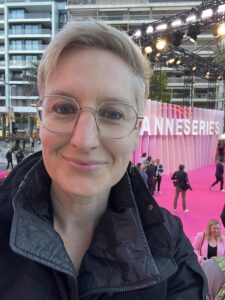
The artist and photographer Leah Dyjak once had a dream about that about a dozen years ago when the site was still piled with three decades’ worth of George Bryant’s infamous collection of stuff. In Dyjak’s dream, a wave came, washed over the property, and pulled all the accumulated stuff out to sea.
Bryant lived in the house at 471, and his hoarding became so extreme that the town, after years of warnings, evicted him from the property in 2011. Dyjak, with Bryant’s sons, Eric and Hale, and a collection of friends and chosen family, was living there and sorting through it all.
The Bryants also owned the Angel Foods building next door. At one point, that building started to buckle under the weight of the books and documents that Bryant had stored on its second floor. Dyjak and the Bryant boys threw George’s archive out the window and buried it in the foundation of an unfinished house next door, covering it with sand.
The vast sorting job was complicated by the challenge of caring for the aging, ill, and now homeless Bryant. Sometimes, Dyjak wished the ocean would finish the process.
Dyjak’s first encounter with the site and with Bryant was in 2010, when they stopped at Angel Foods.
“George locked eyes with me,” Dyjak recalls, “and said, ‘You have a big nose. I taught my boys in the house over there to like women with big noses.’ ”
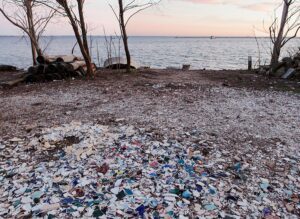
The second encounter came a year or so later. Dyjak was riding a bike down Commercial Street and noticed a tall figure with a buzzed head and black headphones sorting through the piles on Bryant’s lot. Later that day, photographer David Hilliard asked Dyjak to accompany him to take a photo of the same man Dyjak had seen earlier. It was Bryant’s son Eric.
Dyjak and Eric Bryant became romantically involved soon after. They spent the next decade together, a period that saw the sale of 471 Commercial to interior designer Ken Fulk in 2012, Dyjak’s M.F.A. in studio art from the University of Texas, and George Bryant’s death in 2015.
Bryant died of a heart attack while driving on Route 6. Dyjak got the call the day they were installing their M.F.A. exhibition.
“It made sense,” Dyjak says. There was a parallelism of endings: of art-making and of caretaking.
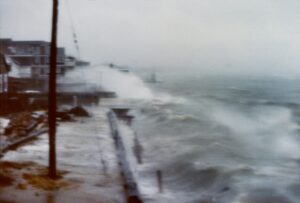
Dyjak says they sometimes strained against gendered differences in the caretaking role they took on. But they don’t regret it.
“I turned the dysfunction of codependently taking on other people’s problems into this site and the care of an elder, which I really stand behind,” says Dyjak. “I know I did everything I could for George. Taking all of this on turned into artwork in a nonlinear, nonquantifiable, queer, feminist way.”
Since childhood, dreaming has been both a propulsive and sustaining force for Dyjak. It keeps them moving but also helps ground them in the textures, ruptures, and lights of the geographic and cultural spaces they inhabit.
At 16, Dyjak had a dream about buying a camera. On the way later that day to a lifeguard shift at Six Flags New England in Springfield, where they grew up, they stopped at a store and bought a 35-mm camera.
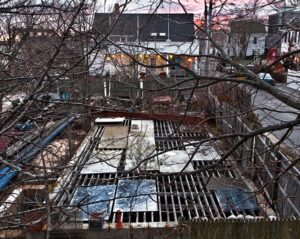
The photography they have produced since maps a reality in which once clearly delineated boundaries become blurred and reconfigured. Dyjak clicks through the photographs on their website and brings a viewer into intimate relation with their memories.
One series of photographs, Boo’s House, is an ode — it captures Bryant in his house in a poetic way. New Beach, now preserved by the Archive of Documentary Arts at Duke University, is about fissure: it captures the crumbling edge between the build environment and the sea. Collect/Disperse, which documents George Bryant’s practice of smashing plates and other crockery to grade his lot between street and bay, is what Dyjak calls an activation, a way to open the site’s past to the community.
After Bryant died, Dyjak continued to hold twice-annual plate smashings on the site “to honor history and rewrite the future.” The plate smashing has been on hold for the last three years, but they are thinking about resuming it this fall. The Bryant family continues to own the Angel Foods property and the plot between it and 471 Commercial.

“The site is in a kind of limbo,” says Dyjak, “in the sense that it’s hovering between the no-longer and the not-yet.”
Even in its relative dormancy, the site has remained a hub for gatherings and expression. Some of Dyjak’s friends from New Orleans staged a screening there last summer; others have rehearsed poetry performances for the Edinburgh Festival Fringe and built fires in the hearth of the shed on the property known as the blacksmith shop.
Dyjak says it is not about claiming the site or forcibly molding it into some static manifestation of internal vision but letting it be what it needs to be. There is something inherently radical about that act, especially in a place that has been reconfigured profoundly in recent years to become increasingly inaccessible.
“We’re riding the coattails of this reputation of Provincetown as an arts colony, but there’s no space or place for impromptu gatherings or fringe-y experimentation,” says Dyjak. “The dream for me is that it remains a creative site — a sculpture park and installation and performance space that is in conversation with the programming at the Vorse house.”
Commercial Street could become the reflective, reinforcing mirror between the highbrow and the gritty and experimental, the way it was 50 years ago “before the big money and white pants,” they say.

Dyjak, now a professor of photography and video at Wheaton College in Norton, returns to Provincetown every summer and at least once a month in the off-season. Their work is represented by the Schoolhouse Gallery, and they recently shifted to work in film and television with both a screenplay and queer home renovation show in the works. The move is a natural progression: the Commercial Street site, after all, was its own kind of set.
The site still drives Dyjak’s personal and artistic inquiry, but time and the physical erosion of shape and composition have changed their relationship to it.
“I feel much more like an artist and an architect now rather than a caretaking family member,” they say.
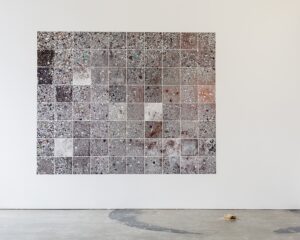
On a visit in late February, Dyjak picked up a piece of the mosaic of broken crockery underfoot, which is a foot deep in spots. They pointed to the once-sharp edges smoothed over by wind, water, salt, and sand, and then placed the shard on their palm: a small center of gravity in the universe of an outstretched hand.
“My attachment to the site is partially about the artwork,” they say. “The most important thing to me is the fact that I can go down that ladder and swim half a mile out at high tide and be alone, be with God, say my prayers, and ask for guidance.”
